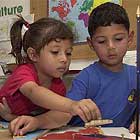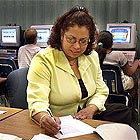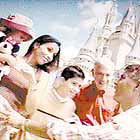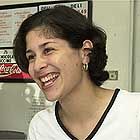|
 |
|
Esta página no está disponible en español. Hispanic Migration Soars, Diversifies, In Central FloridaHispanic Population DiversifiesCounty’s Flavor DiversifiesMore Puerto Ricans Make County Home
Hispanic Migration Soars, Diversifies, In Central Florida By Jeff Kunerth and Kelly Brewington April 24, 2002 Rush-hour traffic was backed up Tuesday morning on the East-West Expressway as Rosibel Monge dropped off her 4-year-old son, Erick Gonzalez, at the preschool inside a small Hispanic church on Lake Underhill Road. The Montessori Bilingual Academy is a little United Nations of Hispanic nationalities. Gonzalez is Costa Rican and Mexican. His classmates are from Venezuela, Chile, Colombia, Ecuador, Cuba, Mexico and Puerto Rico. They reflect what the latest census figures, released today, reveal: Central Florida is an increasingly diverse Hispanic stew of nationalities ranging from Panamanians, Peruvians and Paraguayans to Colombians, Chileans and Dominicans. "We're a melting pot. We're from all parts of the world," said Lucelis Maldonado, the Puerto Rican owner of the preschool. Not far from Maldonado's preschool on Lake Underhill is a Dominican grocery store and an Argentine restaurant. On nearby Curry Ford Road, there's a Cuban-owned produce stand, an Italian restaurant run by Ecuadorean and Mexican partners and a Cuban restaurant with a Dominican owner and Argentine waitresses. Often overshadowed by Puerto Ricans, who comprise half the region's 323,000 Hispanics, other nationalities struggle to retain their customs, pride and identities. "I'm always having to convince people that I'm not Puerto Rican," said Karla Argueta, who arrived in Orlando with husband Gabriel in 1985, fleeing political strife in her native Nicaragua. "People don't even ask me what country I'm from; they just assume." Back then, the Arguetas didn't know anyone from their home country. Today Central Florida is home to 1,478 Nicaraguans. "We're not like the Mexicans, who have an area in Apopka, and we're not like the Puerto Ricans, who are everywhere," she said. "But we're here." Puerto Ricans, Mexicans and Cubans so dominate the Hispanic community in Central Florida that the other nationalities often feel invisible. Rosibel Monge watches Hispanic television stations and listens to Hispanic radio broadcasts, but what she hears and sees is mostly geared to Mexicans and Puerto Ricans.
Even the Dominicans, whose numbers have nearly tripled to about 11,000 residents in the past 10 years, rely on the larger Hispanic groups when they want to celebrate their native culture. The social organization for Domincans holds its gatherings -- including Dominican Independence Day on Feb. 27 -- at a facility owned by a Cuban organization. "The few times we go there, we've had a good time," said Victor Nunez, 42, who owns the La Criolla grocery and deli. And although many Americans have adopted Cinco de Mayo -- Mexico's Independence Day -- as a sort of Hispanic St. Patrick's Day with margaritas instead of green beer, other Hispanics don't join the celebration. "Cinco de Mayo means nothing to us," said Gladys Campo, 29, a computer engineer who moved to Orlando from Colombia three years ago with her husband and daughter. The family celebrates Colombia's Independence Day on July 20 with a few Colombian friends from work. They have a barbecue, listen to Colombian music and dance. It's one of the rare moments when Gladys Campo feels a part of a community of Colombians.
Cultural differences also create feelings of isolation among the smaller Hispanic nationalities. "We are more serious than the other countries. We don't share a lot of things with other Hispanics," said Julio Maureira, 31, a computer engineer from Chile. He was offended when Puerto Rican co-workers told him to speak English instead of Spanish when Americans are present: "I was surprised. I didn't know if they were ashamed of being Latin American." Hispanics from other countries may come to Central Florida for a better life. Maureira and many of his Chilean friends are here to work, gain a master's degree, raise their children to speak fluent English and then return to Chile. "Chileans, I think, we are looking for different things," Maureira said. Following South Florida With its growing Hispanic population, Central Florida is following the footsteps of South Florida, where 34 percent of the population is Hispanic. In Orange, Seminole, Osceola, Lake, Brevard and Volusia counties, Hispanics represent 13 percent of the total population. Seminole County has as many Hispanics -- 40,000 -- as Broward County had in 1980 and about the same portion of Hispanics -- 11 percent -- as Palm Beach County has now. Orange County has a slightly higher percentage of Hispanic residents -- 19 percent -- than Broward County. Osceola County, with nearly 30 percent of its population Hispanic, is approaching where Miami-Dade County was in 1980, when 36 percent of its residents were Hispanic. "You are certainly moving along in the direction of us, but we are much more concentrated," said Dick Ogburn, head planner for the South Florida Regional Planning Council, which covers Broward, Monroe and Miami-Dade counties. But although Orlando's Hispanic community has grown to reflect a large mosaic of cultures, experts aren't calling it the next Miami. From the numbers, this region's Hispanic community is far from the magnitude and influence of South Florida's. Central Florida's total Hispanic population is only about a fourth of Miami-Dade's 1.2 million Hispanics. Nearly 60 percent of Miami-Dade's population is Hispanic, about half of which is Cuban. "I see the Hispanic community growing there, but I don't know if I see it becoming as dominant," said Thomas Boswell, a University of Miami professor of geography and an expert on Hispanic migration. Both regions have a dominant Hispanic group -- Cubans in South Florida and Puerto Ricans in Central Florida -- but Puerto Ricans don't command the same political clout in Central Florida as Cubans have in the southern end of the state. That's partially because Cubans have much larger numbers, Boswell said. In addition, Miami-Dade lost 119,000 non-Hispanic whites during the 1990s. South Florida is becoming a region where it is increasingly important to be bilingual and where competition is still for jobs that are oriented toward Latin America,Boswell said. Hispanic enclaves In Central Florida, Osceola is home to some of the fastest-growing Hispanic groups in Central Florida. Colombians living in Osceola, for example, grew 373 percent during the '90s to 2,071. Bill Hansen, who founded the Hispanic Business Council in Osceola County, has a ground-floor view of the change. "Ten years ago, I advertised for a bilingual secretary. I got 11 or 12 applications from Puerto Ricans, one from a Colombian, one from a Venezuelan and one from other places," said Hansen, who publishes the Osceola Star newspaper. "Six months ago, I advertised again. Now, I got applications from 10 Colombians, two Puerto Ricans and one from here and there." As their numbers grow, some Hispanic nationalities have congregated into ethnic enclaves -- from the Venezuelans at Tivoli Place Apartments in Kissimmee to the Salvadorans who settled along Lancaster Road in Orlando. In the 1990s, Venezuelans leapfrogged from the ninth-largest Hispanic group in the region to the sixth -- surpassing Peruvians, Ecuadoreans and Panamanians. Venezuelan native Yamilet Torres, 36, moved to Orlando 18 years ago and helped add to that diverse stew of Hispanics. Working for Oracle, she recruited about 100 employees from Venezuela, Peru, Chile, Argentina, Brazil, Ecuador, Colombia, Costa Rica, Puerto Rico and Mexico for the software company's Latin American operations. Orlando is far more receptive to Hispanic immigrants than it was in the 1980s, she said: "They are used to foreign accents. That makes it easier." Colombians -- Central Florida's fourth-largest Hispanic group -- increased by more than 7,000 residents as immigrants fled that country's political unrest and years of violence. There are now more Colombians in Central Florida than there were Cubans in 1990. "When I first got here in 1974, I could count the Colombians on my two hands," said Harold Delgado, past president of Central Florida's Colombian American Civic Council, which formed in 1997. "Now the newcomers can easily find us. We are very well known in the community." Delgado fled first to Queens, N.Y., in 1961. After a family vacation in Orlando, he relocated here, seeking a tranquil locale in which to raise his two daughters. It wasn't long before he prodded co-workers, friends and family in Queens to join him in Orlando. They followed en masse. "I'd say I helped bring a little more than 100 people down here," he said. "If you have the opportunity to get a good job for your friend or countryman, then you tell them. They tell their friends and family, and before you know it, everyone is here." The same dynamics apply to other Hispanic nationalities. Fifteen Hispanic groups have more than 1,000 residents in Central Florida, according to the census. A decade ago, there were 11. Distinctions and tensions The distinctions among groups has sometimes caused tension in Central Florida's Hispanic organizations, said Zulma Velez-Estrada, a member of the Puerto Rican Chamber of Commerce and independent business consultant. The Puerto Rican Chamber of Commerce was formed in 1986, while the heavily Cuban-influenced Latin Chamber of Commerce had been around since 1981. In 1992, after recognizing that they shared a common mission, the groups joined to form the Hispanic Chamber of Commerce of Central Florida. However, not everyone agreed it was the best idea, Velez-Estrada said. "Things became political," she said. "A minority of Puerto Ricans thought the Cubans had too much power." But the conflicts continued, and another Puerto Rican chamber formed about five years ago, she said. Ayme Rodriguez Smith, who helped organize the recently formed Democratic Hispanic Caucus, said Hispanics can't let their differences come between them if they want to make progress in the political arena. "We can't faction off, because then we lose our strength," she said. "Although we have our differences, we have a great deal in common." National pride can distract the issues that are important to all Hispanics, said Rodriguez Smith, who is Cuban. "I think it's difficult to say, for example, I'm Cuban, but I represent the entire Hispanic community," she said. "There's competition and one-upmanship that makes it difficult to work together." Despite the distinct cultures and dialects, the many Hispanic groups are united by religion and language. "The Hispanic is a tight culture," said John Vega, a 44-year-old Ecuadorean businessman. "Religion keeps us united more than anything else." Catholicism may be the fruit of the Hispanic soul, but it is semantics that flavors the stew. "The Chileans say porotos, the Puerto Ricans say habichuelas and the Cubans say frijoles-- but it all means beans, you know?" said Marytza Sanz, who works with Latino Leadership, a grass-roots group. "We all have our own sayings, but the language is what will always keep us together."
Hispanic Population Diversifies By Sean Mussenden April 24, 2002 DELTONA -- At any one of the busy Hispanic grocery stores that have popped up in this city since 1990, shoppers can find goods from across Latin America. Sure, much is shipped from Puerto Rico, but look closely and there's vanilla from the Dominican Republic, melons from Panama, yucca from Costa Rica, and Colombian corn cakes. Deltona's winding streets offer similar representation. During the past decade, according to new U.S. Census Bureau data, Hispanics from a half-dozen countries that did not have a foothold a decade ago are slowly adding to the city's decades-old, Puerto Rican-dominated Hispanic melting pot. People with ties to Central American countries such as Guatemala, Honduras and Costa Rica, and from Paraguay in South America, appeared for the first time on C census roles, but they – and families from Cuba, Columbia, and a dozen other Latin nations – are still the exception to the Puerto Rican rule. The product of massive immigration from Northern states such as New York and from the island, thousands more Puerto Ricans are calling Volusia home – mostly in the county's fast-growing southwest area. The Puerto Rican community in Volusia County more than doubled during the l past decade. In Deltona, that population almost tripled, giving it one of the state's highest percentages of Puerto Ricans. "A lot of people are coming down to better themselves. They can buy a house with $5,000 down. It takes that much to rent an apartment up North," said Blanca Hernandez, president of the Volusia County Hispanic Association and a local Realtor. "Everyone wants a piece of the American dream. That's what it really boils down to." Elba Mercado's family moved from Puerto Rico to Orange City more than two years ago in search of a better life. Her husband, Saul Villafane, was a chemist for a pharmaceutical company there. She worked as a medical technologist, earning $7 an hour – half as much as she could make in the States. "That's a big difference for the same job," said Mercado, 29. Nevertheless, she and her husband haven't gone back into their old lines of work. They now live in Deltona, where they co-own a bakery, one of a growing number of Hispanic-owned stores from Pierson to Deltona. Hernandez said the stage for a massive Puerto Rican influx was set decades ago, when Deltona's planners actively sought buyers on the island. Many bought homes but rented them out and stayed in Puerto Rico. Now in retirement, they're moving to Florida and bringing younger family members with them. In Pierson, a farming town where Mexicans have toiled in the fern fields for years, the 1990s had the opposite effect, according to new census data. The Mexican community stood at almost 2,000 in the 1990. It fell to a little under 1,600 in the 2000 count, making it one of the few Hispanic groups to have its ranks thinned in any Volusia city. A promise of better working conditions and more money elsewhere and a lack of housing led many to pack their bags, said Alfredo Bahena, a farm-worker advocate in Pierson. "I think the problem is the farm industry doesn't give farm families incentives to continue doing farm work," he said. They took to low-skill jobs in DeLand and points south – everything from landscaping to construction work to fast food. Bernardo Benavids, 29, stayed in Pierson, though he now works at a butcher shop instead of the fields. He watched as friends trickled out of town during the 1990s. Some went as far as Arkansas to work construction. Others found better conditions picking tomatoes somewhere else. Others went home. He moved here in the late 1980s. He has two little girls – one 6, the other 3 – and he's not about to leave. "It's like I've lived my whole life here," he said. "I have roots here." Volusia County Hispanics
Hispanics in West Volusia cities
SOURCE: U.S. Census Bureau
County’s Flavor Diversifies By Susan Jacobson April 24, 2002 KISSIMMEE -- When Patsy Heffner was growing up in Kissimmee in the 1950s and early 1960s, the most popular restaurants in town served down-home Southern food, burgers and milkshakes and diner fare. Today, Heffner, 56, now Osceola County tax collector, can choose Mexican, Dominican, Puerto Rican or Colombian eats almost within walking distance of her downtown Kissimmee office. "You can go to a different country every night," Heffner joked. Osceola County's Hispanic population jumped 296 percent from 1990 to 2000, the U.S. census shows, and a newly released breakdown of that increase shows a whopping 1,125 spike in the number of Venezuelans, although that community, at 686 in 2000, is still small. Puerto Ricans remain by far the dominant Hispanic group in the county, growing 280 in the 10-year period. Nearly 31,000 of Osceola's almost 51,000 Hispanics are of Puerto Rican descent. Nicaraguans, Argentines ** and Salvadorans posted higher- percentage increases, but the populations are much smaller. In terms of raw numbers, the Mexican population increased by 2,239 people, or (193 percent) and the 2000 census counted 2,071 Colombians, a 373 percent increase. Miguel Alvarez, owner of La Campiña Records in Kissimmee and Orlando, estimates that more than three times as many Colombians call Osceola home as the census reported. Many come to escape kidnappings and murders by guerillas and paramilitary groups in their home country. "Puerto Ricans come here because they want to change their lives," said Alvarez, a Colombian who moved to New York 15 years ago. "Colombians are here because they want to have a life." The influx of Hispanics has changed the face of Osceola County in more ways than just culinary. County offices and the courthouse have hired Spanish-speaking employees to communicate with the burgeoning Hispanic population, which is nearly 30 percent of all county residents. "It's going to be a huge impact in the November elections," said Edgar Silva, 40, an American of Colombian descent who has lived in Kissimmee since 1994. Silva said Hispanics will continue to flock to Central Florida in search of a better life. "We are determined to have better jobs, better opportunities," said Silva, who works for a furniture-import company. "It's going to keep growing."
More Puerto Ricans Make County Home By Katherine Leal Unmuth April 24, 2002 CLERMONT -- When Kissimmee started to feel crowded to Hilda Berrios, she began searching for some peace and quiet. She found it in the rolling hills and lakes of Lake County. "It's like the suburbs," said Berrios, a teacher at Mascotte Elementary School. "That's why I picked Lake County. When I moved to Kissimmee, it was really a nice small town. But it grew too fast," she said. Five years ago she moved here with her husband and two children, becoming one of a growing number of Puerto Ricans moving into south Lake County. According to the 2000 census, the number of Puerto Ricans in Lake County grew 400 percent between 1990 and 2000, from 595 people to 2,978. The county's Hispanic population historically has been, and still is, dominated by Mexicans. The census counted 5,638 in Lake County, the only county in the area in which Mexicans outnumber Puerto Ricans. In Lake County, Hispanics still only make up about 6 percent of the population, while in Osceola they constitute 29 percent. Berrios said she often returns to Kissimmee to go shopping and visit family. "There's so many Puerto Ricans, it's a Spanish country over there [in Kissimmee]," said Berrios, who was born on the island. Much of Lake County's growing Puerto Rican population is concentrated in the quickly developing Citrus Ridge area, near where Lake, Polk, Orange and Osceola counties meet. Monica Potter, literacy director for the county library system, said the growth is reflected in the demand for English classes at the Citrus Ridge Library. She said two English classes are being taught and 20 people are on the waiting list. "There is definitely a tremendous need out in the Citrus Ridge area," Potter said. Berrios also teaches English to Mexican migrant workers at night, and she notes key differences between the two groups. "It's doubly hard for them to learn the culture, the language," she said. "In Puerto Rico, we're educated in English, so when we come over to this country we're prepared." Felix Ramirez, vice principal of Mascotte Elementary School, has noticed both Mexican and Puerto Rican workers settling in the area. "They [Mexicans] have diversified and gone into the construction business or education and other occupations," he said. "The majority of the people have settled. And now we have this new wave of Puerto Ricans coming in." Dr. Tom Ballesteros, 51, originally from Puerto Rico, moved his family here in 1995 after he retired from the Air Force. "I was looking for an opportunity, and this area had a lot of economic potential," said Ballesteros, a dentist who practices in Clermont. "We saw that the area was developing. It was just a gorgeous community, a very beautiful community. Great place to raise a family." He said he has not seen many Hispanic patients at his practice, though. Berrios knows other Puerto Rican professionals who have also chosen to move to the smaller Lake County communities. However, she said the Puerto Rican community is spread out and still small. "But I know that they're moving," Berrios said. Fastest-growing Hispanic groups in Lake County
SOURCE: U.S. Census Bureau
| ||||||||||||||||||||||||||||||||||||||||||||||||||||||||||||||||||||||||||||||||||||||||||||||||||||||||||||||||||||||||||||||||||||||||||||||||||||


 "It makes me feel like we are ignored, but we are such a small community," said Monge, a software engineer. "The majority rules, so what can we do?"
"It makes me feel like we are ignored, but we are such a small community," said Monge, a software engineer. "The majority rules, so what can we do?" "I don't feel like there is a community here. I can't find a place where every Colombian meets," she said. "You feel like you are alone sometimes. You feel lonely."
"I don't feel like there is a community here. I can't find a place where every Colombian meets," she said. "You feel like you are alone sometimes. You feel lonely."